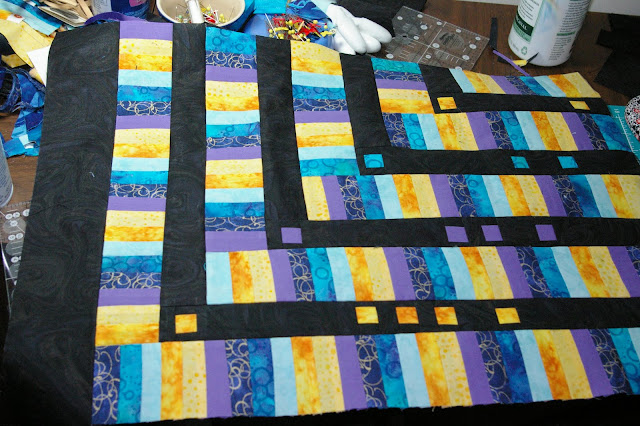The workshop was held at a local Fire Station. And turns out to be a great space - though for some projects, I would be inclined to pack an Ott Lite as well.
A few years ago, Gus took a great picture of Dash when we were visiting Mimi & Papa Bill in Arkansas. This was the day after he snarfed down 1/3 of a box of rat poison, and clearly is feeling no pain. Though I'm sure he was a bit offended by the emergency vet visit... I like the basic composition and the glint in his eyes.
The workshop was taught by Aniko Feher - http://www.quiltsbyaniko.com/qba/home.html - and the workshop the guild offered was Pet Portraits.
Using the picture above, I set out to create a Dash Quilt. The first step (and as it turns out first hurdle) was to enlarge the photo - in this case to 8 x 10 - cropped to focus on Dash. Unfortunately, we lost a bit of resolution in the enlargement, so there are softer lines. And, as it turns out, my home computer is low on both cyan and magenta, resulting in a pink tinted photo. I did print out several versions of black & white, playing with the contrast along the way - to highlight his shiny white coat.
Using the various black & white printouts along with the portrait taken by Alvin Phillips after he finished his AKC Championship, I set out to create a paint-by-number version of Dash. As you can see from my sketch, I've decided not to replicate my ankle or the novel on the back of the sofa. I haven't decided on all of the background, but I think I'm going to create a quilt for him to rest his feet on and possibly a cushion on his left.
As a group we trekked to Staples to photocopy and in some cases to enlarge our drawings. It took a little time for us to figure out how to work the dratted copiers, but once we figured out how to enlarge, we were off and running.
Back at the fire station, we numbered from light to dark - or in my case, light to dark and then pink for the inner ear. I then traced my enlarged Dash onto another piece of mylar as I had extra. I picked three whites, three golds, dark brown, black and a pinky orange as my key colors. Then traced the design by numbered parts, this time on freezer paper - which was applied to the fabric swatches and then to the base piece.
At this point colors 1, 2 and part of 4 have been placed onto color 3
We ran out of time at the workshop, so after dinner with the guys, I finished trimming and placing colors 5 & 6.
Colors 1-5, 7-9 are in place.
And now he is pressed into place and ready to stitch the pieces in place. Once he is stitched down, I'll cut him out and place him onto his background and finish the wall hanging.
It is interesting to note, in person, the solid white is brighter than the printed white on white, but in the pictures, it looks like the printed white is more reflective. I'll be adding some thread painting on his white parts, especially his feet, which often do glisten.
Gus has laid claim to him. Monkey doesn't know it, but she is next.







































